Design and Analysis of a Novel Hydraulic Energy Storage Component
Abstract
1. Introduction
2. Design of NHESC
2.1. System Configuration
2.2. Modeling
2.2.1. Hydraulic Unit
2.2.2. Air Unit
2.2.3. Electrical Unit
2.3. Working States
3. Determination Strategies of Working States
3.1. Energy Absorption Determination Strategy
- ①
- Consider whether the air unit pressure exceeds its maximum rated pressure ; If the exceeds , then the NHESC can only stop working; otherwise, it will enter ②.
- ②
- After determining whether the air unit can absorb energy, it is necessary to determine whether the external hydraulic circuit pressure is greater than the hydraulic unit pressure , and if so, then it can enter ③; otherwise, it will enter ④.
- ③
- The value of SOC determines whether the electrical unit can absorb energy normally, and if the SOC is lower than SOCmax, then it enters state B; otherwise, it enters state A.
- ④
- If the SOC is greater than the SOCmin, then state C is entered; otherwise, the NHESC stops working.
3.2. Energy Release Determination Strategy
- ①
- First, it is necessary to determine whether the volume of the hydraulic unit is sufficient for energy release. If the hydraulic unit volume exceeds its minimum working volume , then it can enter ②; otherwise, the NHESC stops working.
- ②
- When the SOC is greater than SOCmin, the NHESC can directly enter state E or ③; otherwise, it can proceed to ④.
- ③
- If the SOC is less than SOCmax and the hydraulic unit pressure is greater than the pressure of the external hydraulic circuit, then the NHESC enters state F.
- ④
- If the SOC is greater than SOCmax and the hydraulic unit pressure is greater than the external hydraulic circuit pressure , then the NHESC enters state D.
4. Simulation and Experiment
4.1. Experimental Platform
4.2. Simulation Model
4.3. Experimental Verification
- (1)
- A no-load boom movement cycle consists of: Bottom (1.5 s), Rising (1.5 s), Stop at the top (2.5 s), and Falling (1.0 s);
- (2)
- Displacement of the piston rod of the boom cylinder: 0.32 m (bottom) and 0.45 m (top).
5. Energy Efficiency Analysis
5.1. Comparison Between NHESC and Hydraulic Accumulator
5.2. Energy Regeneration Efficiency Analysis
5.2.1. Definitions
5.2.2. Recovery Efficiency
5.2.3. Reuse Efficiency
5.2.4. Regeneration Efficiency
5.3. Energy Loss
6. Conclusions and Prospects
- (1)
- The structure of the NHESC was described, models of its main components were established, and six possible working states of the NHESC during the energy absorption and release processes were identified.
- (2)
- Strategies for determining entry into the six working states of the NHESC were provided.
- (3)
- The NHESC’s effectiveness was confirmed through a boom PER system simulation on a 1.7-ton mini-excavator. Experimental data identified B-E as the optimal working state pair.
- (4)
- The analysis of the boom PER system compared state pair B-E in both NHESC and accumulator modes, evaluating recovery, reuse, and regeneration efficiencies. The NHESC achieved a regeneration efficiency of 55.1%, exceeding the accumulator’s 41.1%.
- (1)
- We intend to validate and optimize the threshold settings of the NHESC’s strategy for determining its working state under complex real-world conditions to ensure reliability and adaptability.
- (2)
- Developing comprehensive experimental platforms that can simulate complex operating conditions will enable a thorough evaluation of the NHESC’s performance across various scenarios.
- (3)
- Investigating advanced control strategies will facilitate precise regulation and optimization of the NHESC’s operating states, thereby improving the system’s dynamic response capabilities.
Author Contributions
Funding
Data Availability Statement
Acknowledgments
Conflicts of Interest
Abbreviations
| CV | check valve |
| DVn | directional valve n |
| HER | hydraulic energy regeneration |
| HESC | hydraulic energy storage component |
| HHEs | hybrid hydraulic excavators |
| HHV | hydraulic hybrid vehicle |
| HRB | hydraulic regenerated hydrostatic |
| HTSs | hydraulic transmission systems |
| ICE | internal combustion engine |
| MG | motor/generator |
| NHESC | novel hydraulic energy storage component |
| PDV | proportional directional valve |
| PER | potential energy regeneration |
| RESs | regenerative energy suspensions |
| TV | throttle valve |
References
- Dindorf, R.; Takosoglu, J.; Wos, P. Review of hydro-pneumatic accumulator models for the study of the energy efficiency of hydraulic systems. Energies 2023, 16, 6472. [Google Scholar] [CrossRef]
- Zhang, W.; Wang, J.; Liu, Y.; Gao, G.; Liang, S.; Ma, H. Reinforcement learning-based intelligent energy management architecture for hybrid construction machinery. Appl. Energy 2020, 275, 115401. [Google Scholar] [CrossRef]
- Li, Y.; Khajepour, A.; Devaud, C.; Liu, K. Power and fuel economy optimizations of gasoline engines using hydraulic variable valve actuation system. Appl. Energy 2017, 206, 577–593. [Google Scholar] [CrossRef]
- Jiang, Y.; He, X. Overview of Applications of the Sensor Technologies for Construction Machinery. IEEE Access 2020, 8, 110324–110335. [Google Scholar] [CrossRef]
- Tan, L.; He, X.; Xiao, G.; Jiang, M.; Yuan, Y. Design and energy analysis of novel hydraulic regenerative potential energy systems. Energy 2022, 249, 123780. [Google Scholar] [CrossRef]
- He, X.; Xiao, G.; Hu, B.; Tan, L.; Tang, H.; He, S.; He, Z. The applications of energy regeneration and conversion technologies based on hydraulic transmission systems: A review. Energy Convers. Manag. 2020, 205, 112544. [Google Scholar] [CrossRef]
- Vu, T.-V.; Vu, T.-H. An Improvement of Rule-Based Control Strategy for a Series Hydraulic Hybrid Vehicle. In AETA 2016: Recent Advances in Electrical Engineering and Related Sciences; Lecture Notes in Electrical Engineering; Springer Nature: Berlin, Germany, 2017; pp. 902–912. [Google Scholar]
- Radu, M. How Peugeot-Citroen’s Hybrid Air System Works: The Car That Runs on Air. Available online: https://www.autoevolution.com/news/how-peugeot-citroen-s-hybrid-air-system-explained-the-car-that-runs-on-air-57554.html# (accessed on 12 July 2024).
- HAMM AG. HAMM HD+ 90i PH Tandem Roller: Environment-Friendly Hybrid Technology Comes as Standard. Available online: https://www.hamm.eu/en/news-media/news-jobreports/2017/02-hamm-power-hybrid.php (accessed on 1 August 2024).
- Lin, T.; Chen, Q.; Ren, H.; Huang, W.; Chen, Q.; Fu, S. Review of boom potential energy regeneration technology for hydraulic construction machinery. Renew. Sustain. Energy Rev. 2017, 79, 358–371. [Google Scholar] [CrossRef]
- Minav, T.A.; Heikkinen, J.E.; Pietola, M. Direct driven hydraulic drive for new powertrain topologies for non-road mobile machinery. Electr. Power Syst. Res. 2017, 152, 390–400. [Google Scholar] [CrossRef]
- Qiao, S.; Hao, Y.; Quan, L.; Ge, L.; Xia, L. A novel electro-hydraulic compound driving system with potential energy regeneration capability for lifting device. IEEE Access 2022, 10, 18248–18256. [Google Scholar] [CrossRef]
- Abdelkareem, M.A.A.; Xu, L.; Ali, M.K.A.; Elagouz, A.; Mi, J.; Guo, S.; Liu, Y.; Zuo, L. Vibration energy harvesting in automotive suspension system: A detailed review. Appl. Energy 2018, 229, 672–699. [Google Scholar] [CrossRef]
- Chandler, D. More power from bumps in the road. MIT Tech Talk 2009, 53, 4. [Google Scholar]
- Zhou, H.; Xu, Z.; Liu, L.; Liu, D.; Zhang, L. Modelling and Control of a Novel Hydraulic Hybrid Vehicle with Wheel Motors. In Proceedings of the 2018 IEEE International Conference on Mechatronics and Automation (ICMA), Changchun, China, 5–8 August 2018; pp. 1985–1990. [Google Scholar]
- Yang, J.; Liu, B.; Zhang, T.; Hong, J.; Zhang, H. Application of energy conversion and integration technologies based on electro-hydraulic hybrid power systems: A review. Energy Convers. Manag. 2022, 272, 116372. [Google Scholar] [CrossRef]
- Wang, Q. Research on Key Technology of Oil-electric Hybrid Excavator. J. Mech. Eng. 2013, 49, 123–129. [Google Scholar] [CrossRef]
- Ng, F.; Harding, J.A.; Glass, J. An eco-approach to optimise efficiency and productivity of a hydraulic excavator. J. Clean. Prod. 2016, 112, 3966–3976. [Google Scholar] [CrossRef]
- Bedotti, A.; Campanini, F.; Pastori, M.; Riccò, L.; Casoli, P. Energy saving solutions for a hydraulic excavator. Energy Procedia 2017, 126, 1099–1106. [Google Scholar] [CrossRef]
- Ranjan, P.; Wrat, G.; Bhola, M.; Mishra, S.K.; Das, J. A novel approach for the energy recovery and position control of a hybrid hydraulic excavator. ISA Trans. 2020, 99, 387–402. [Google Scholar] [CrossRef] [PubMed]
- Kwak, K.S.; Ahn, K.K. Innovative Powertrain for Hybrid Hydraulic Excavators. In Proceedings of the 24th International Conference on Control, Automation and Systems (ICCAS), Jeju, Republic of Korea, 29 October–1 November 2024; pp. 391–396. [Google Scholar]
- Zhang, Y.; Chen, H.; Guo, K.; Zhang, X.; Eben Li, S. Electro-hydraulic damper for energy harvesting suspension: Modeling, prototyping and experimental validation. Appl. Energy 2017, 199, 1–12. [Google Scholar] [CrossRef]
- Wang, R.; Gu, F.; Cattley, R.; Ball, A. Modelling, Testing and Analysis of a Regenerative Hydraulic Shock Absorber System. Energies 2016, 9, 386. [Google Scholar] [CrossRef]
- Zhao, W.; Zhou, X.; Wang, C.; Luan, Z. Energy analysis and optimization design of vehicle electro-hydraulic compound steering system. Appl. Energy 2019, 255, 113713. [Google Scholar] [CrossRef]
- Li, L.; Huang, H.; Zhao, F.; Sutherland, J.W.; Liu, Z. An energy-saving method by balancing the load of operations for hydraulic press. IEEE/ASME Trans. Mechatron. 2017, 22, 2673–2683. [Google Scholar] [CrossRef]
- Wang, F.; Zhang, Q.; Wen, Q.; Xu, B. Improving productivity of a battery powered electric wheel loader with electric-hydraulic hybrid drive solution. J. Clean. Prod. 2024, 440, 140776. [Google Scholar] [CrossRef]
- Li, Z. Research on Characteristics and Energy Efficiency of Hydraulic-electric Combined Driving Hydraulic Excavator Boom. J. Mech. Eng. 2018, 54, 213–219. [Google Scholar] [CrossRef]
- Fu, X.-H.; Cai, M.-L.; Wang, Y.-X.; Shi, Y. Optimization Study on Expansion Energy Used Air-Powered Vehicle with Pneumatic-Hydraulic Transmission. Chin. J. Mech. Eng. 2018, 31, 3. [Google Scholar] [CrossRef]
- Ren, T.; Xu, W.; Jia, G.-W.; Cai, M. A Novel Isothermal Compression Method for Energy Conservation in Fluid Power Systems. Entropy 2020, 22, 1015. [Google Scholar] [CrossRef]
- Xia, L. Operating Characteristics and Energy Efficiency of Hydraulic-gas Combined Driving Hydraulic Excavator Boom. J. Mech. Eng. 2017, 53, 176–183. [Google Scholar] [CrossRef]
- Wang, J.; Yang, Z.; Liu, S.; Zhang, Q.; Han, Y. A comprehensive overview of hybrid construction machinery. Adv. Mech. Eng. 2016, 8, 1687814016636809. [Google Scholar] [CrossRef]
- Ge, L.; Dong, Z.; Quan, L.; Li, Y. Potential energy regeneration method and its engineering applications in large-scale excavators. Energy Convers. Manag. 2019, 195, 1309–1318. [Google Scholar] [CrossRef]
- Lin, T.; Lin, Y.; Ren, H.; Chen, H.; Chen, Q.; Li, Z. Development and key technologies of pure electric construction machinery. Renew. Sustain. Energy Rev. 2020, 132, 110080. [Google Scholar] [CrossRef]
- Minav, T.A.; Murashko, K.; Laurila, L.; Pyrhönen, J. Forklift with a lithium-titanate battery during a lifting/lowering cycle: Analysis of the recuperation capability. Autom. Constr. 2013, 35, 275–284. [Google Scholar] [CrossRef]
- He, X.; Liu, H.; He, S.; Hu, B.; Xiao, G. Research on the energy efficiency of energy regeneration systems for a battery-powered hydrostatic vehicle. Energy 2019, 178, 400–418. [Google Scholar] [CrossRef]
- Gong, J.; Zhang, D.; Guo, y.; Liu, C.; Zhao, Y.; Hu, P.; Quan, w. Power control strategy and performance evaluation of a novel electro-hydraulic energy-saving system. Appl. Energy 2019, 233–234, 724–734. [Google Scholar] [CrossRef]
- Zhang, W.; Wang, G.; Guo, Y. Research on damping and energy recovery characteristics of a novel mechanical-electrical-hydraulic regenerative suspension system. Energy 2023, 271, 127022. [Google Scholar] [CrossRef]
- Lin, T.; Wang, Q.; Hu, B.; Gong, W. Research on the energy regeneration systems for hybrid hydraulic excavators. Autom. Constr. 2010, 19, 1016–1026. [Google Scholar] [CrossRef]
- Hui, S.; Lifu, Y.; Junqing, J. Hydraulic/electric synergy system (HESS) design for heavy hybrid vehicles. Energy 2010, 35, 5328–5335. [Google Scholar] [CrossRef]
- Cytrynski, S.; Neerpasch, U.; Bellmann, R.; Danner, B. The Active Suspension of the New Mercedes-Benz GLE. ATZ Worldw. 2018, 120, 42–45. [Google Scholar] [CrossRef]
- Ven, V.D.; James, D. Increasing Hydraulic Energy Storage Capacity: Flywheel-Accumulator. Int. J. Fluid Power 2009, 10, 41–50. [Google Scholar]
- Zhao, D.; Ge, W.; Mo, X.; Liu, B.; Dong, D. Design of A New Hydraulic Accumulator for Transient Large Flow Compensation. Energies 2019, 12, 3104. [Google Scholar] [CrossRef]
- Strohmaier, K.G. Modeling, Optimization, and Detailed Design of a Hydraulic Flywheel-Accumulator. Ph.D. Thesis, University of Minnesota, Minneapolis, MN, USA, 2014. [Google Scholar]
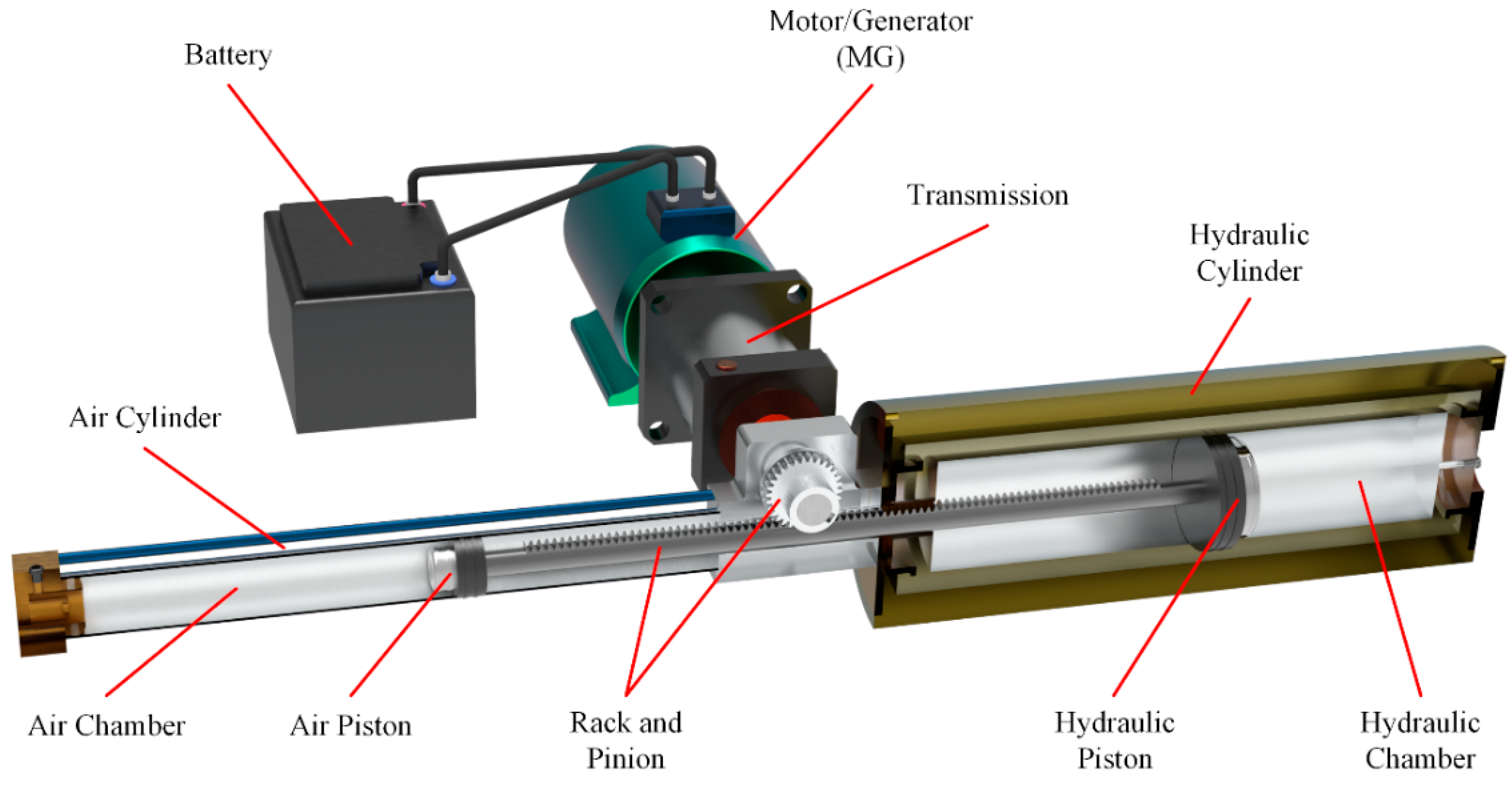
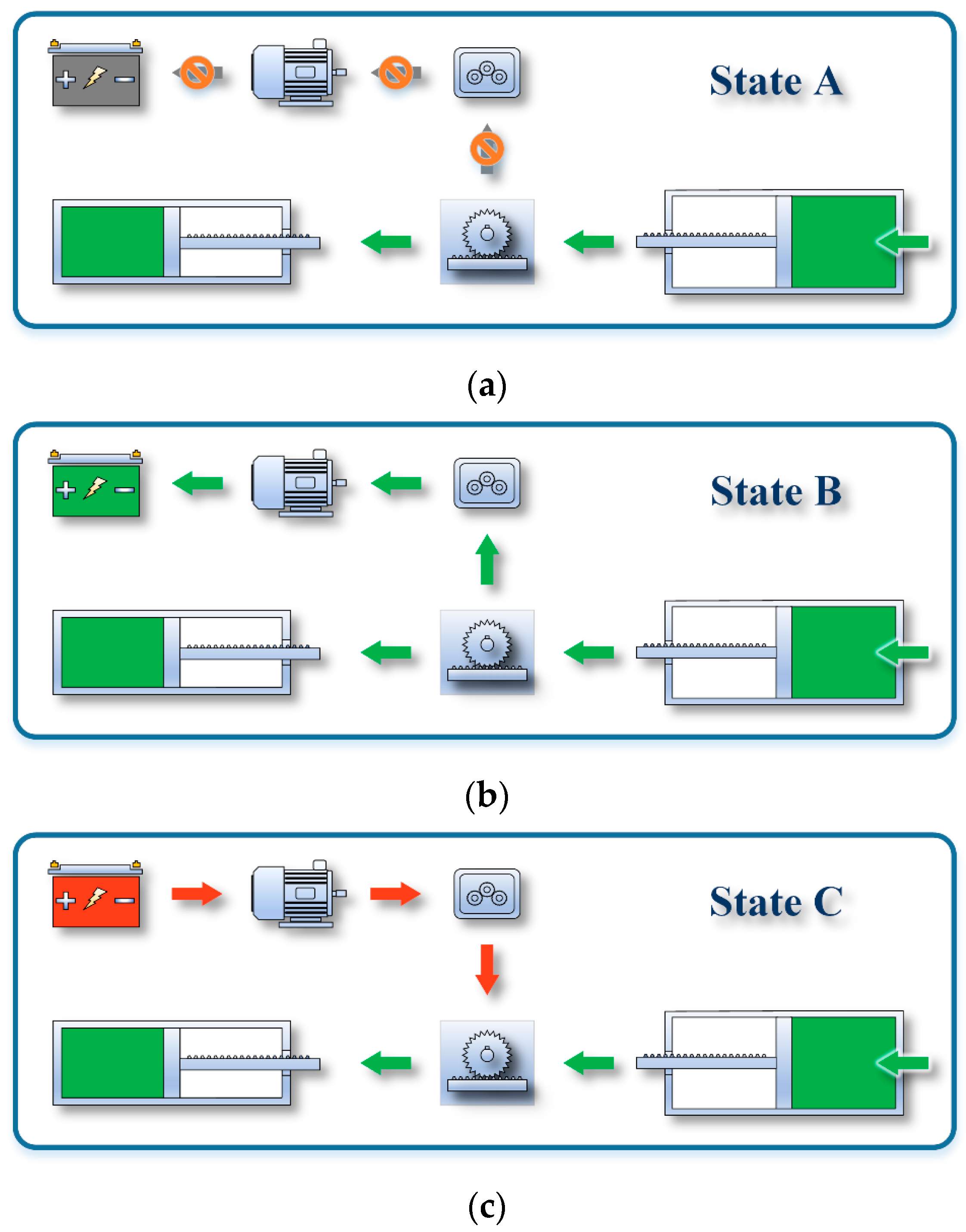
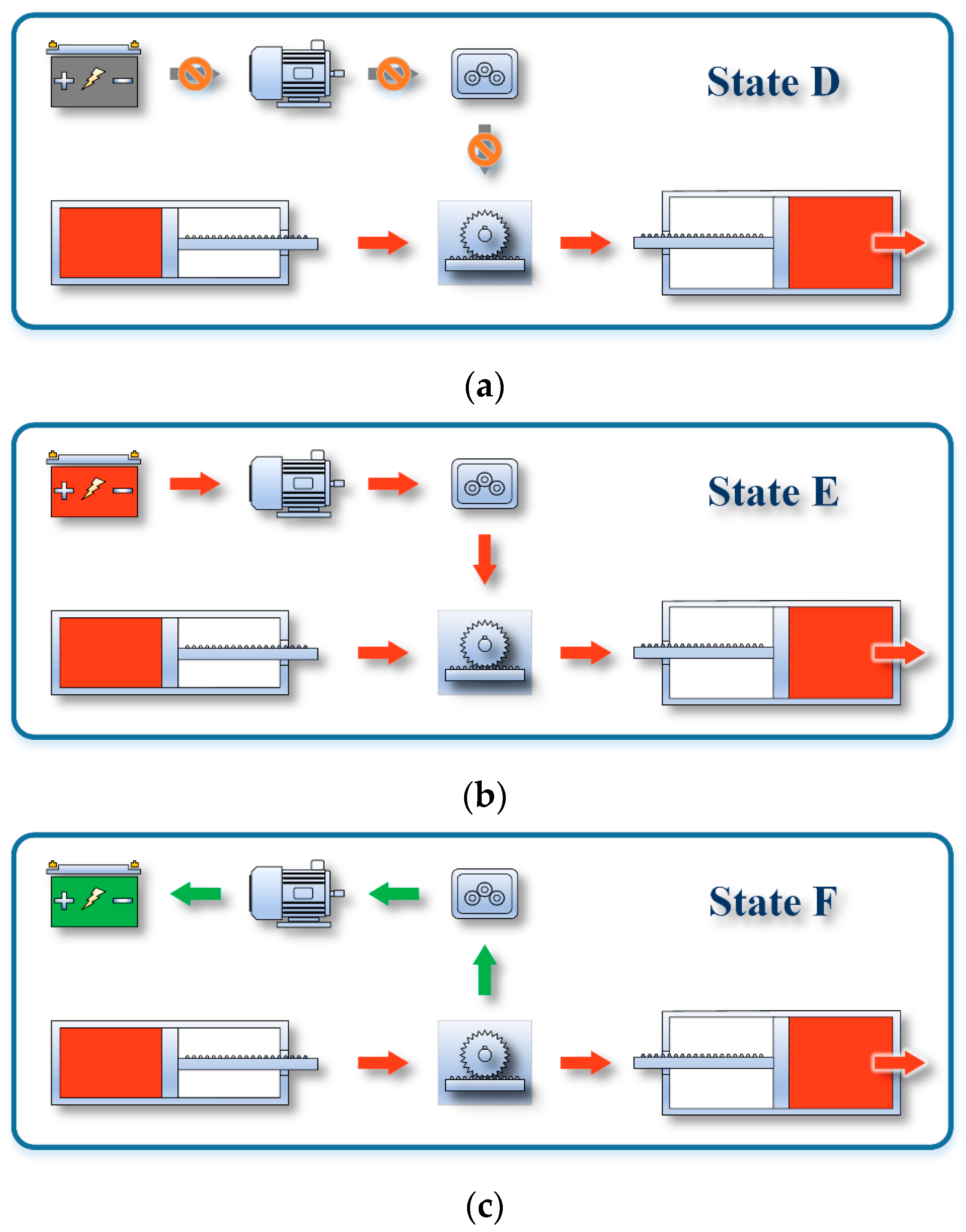
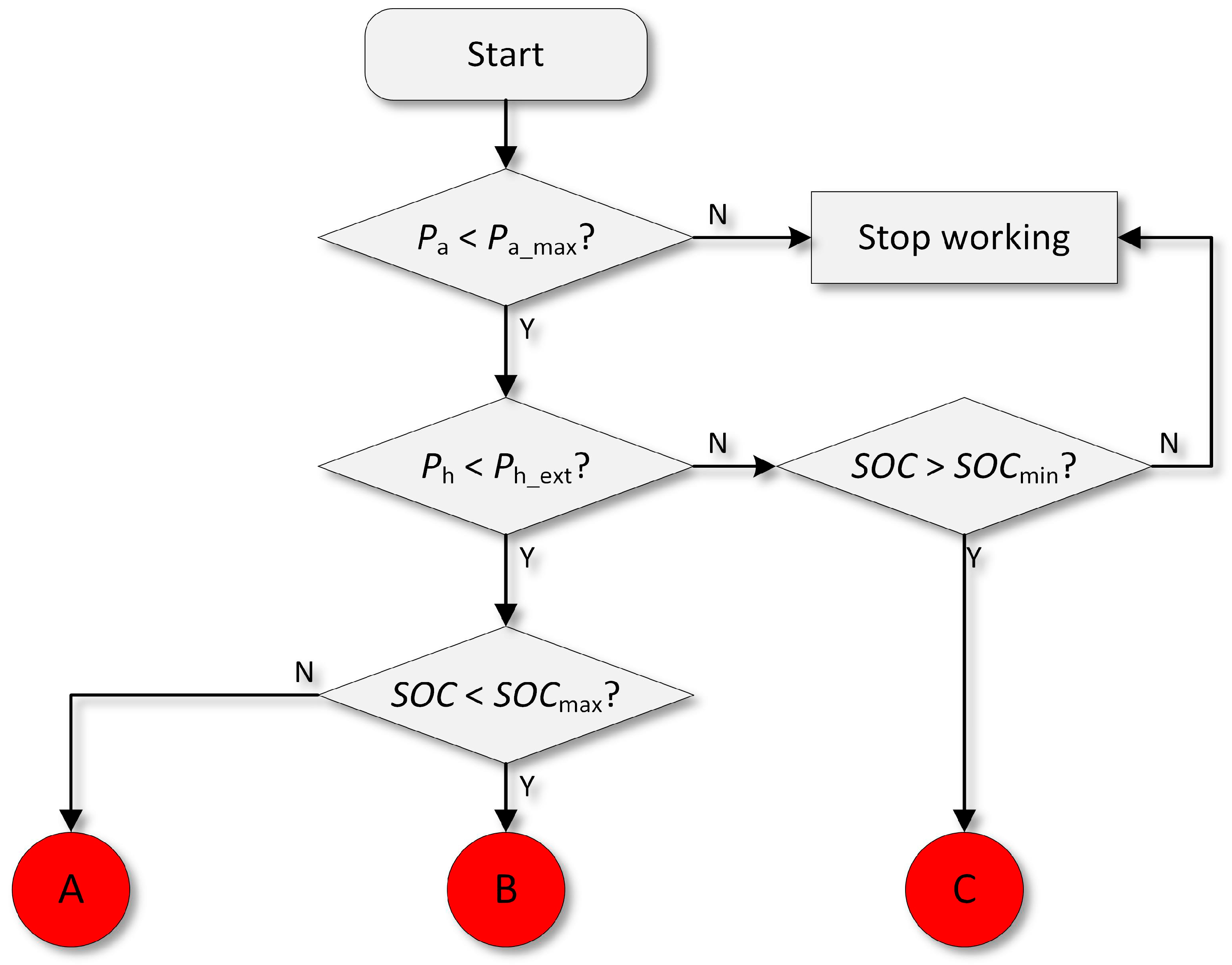
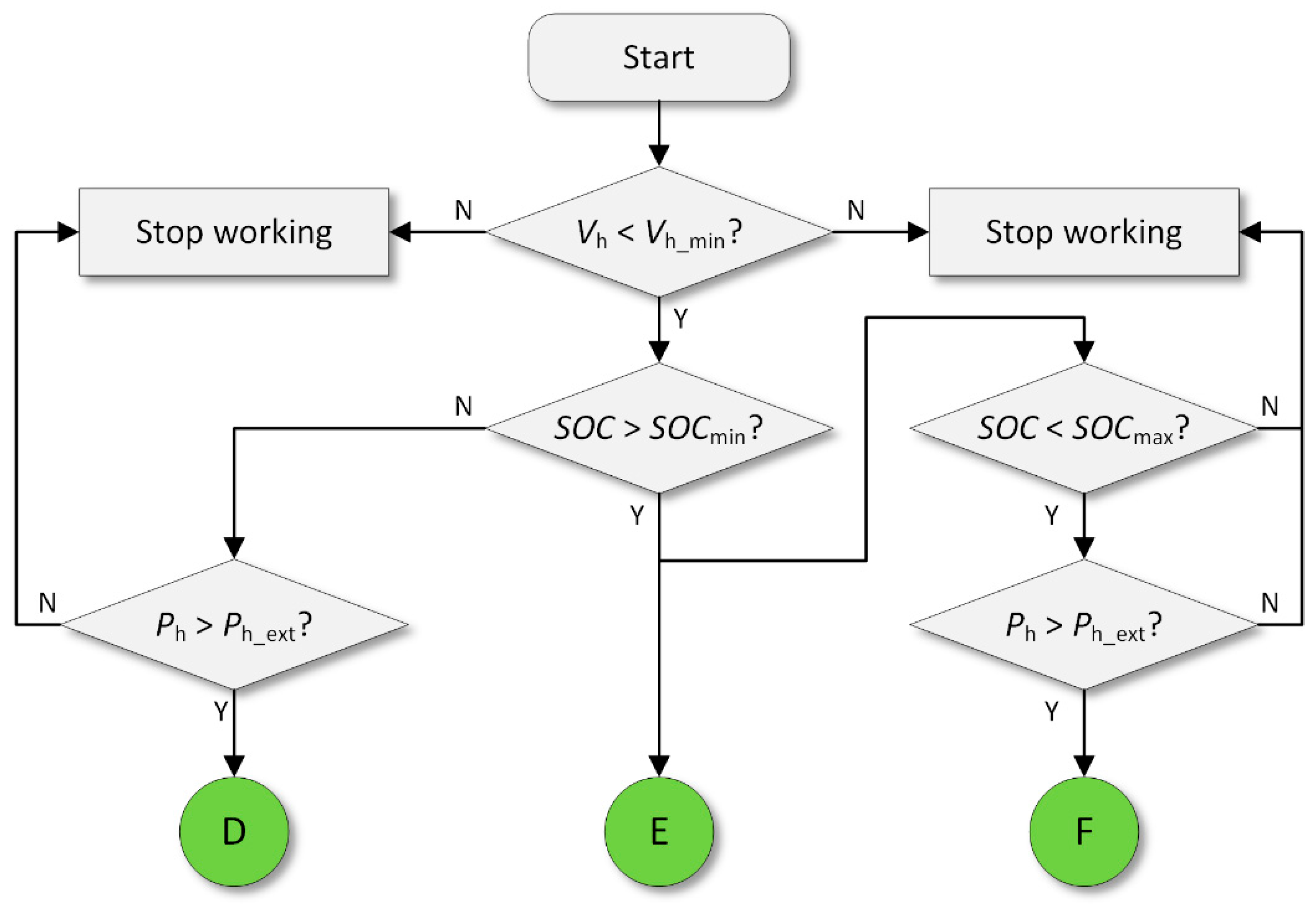
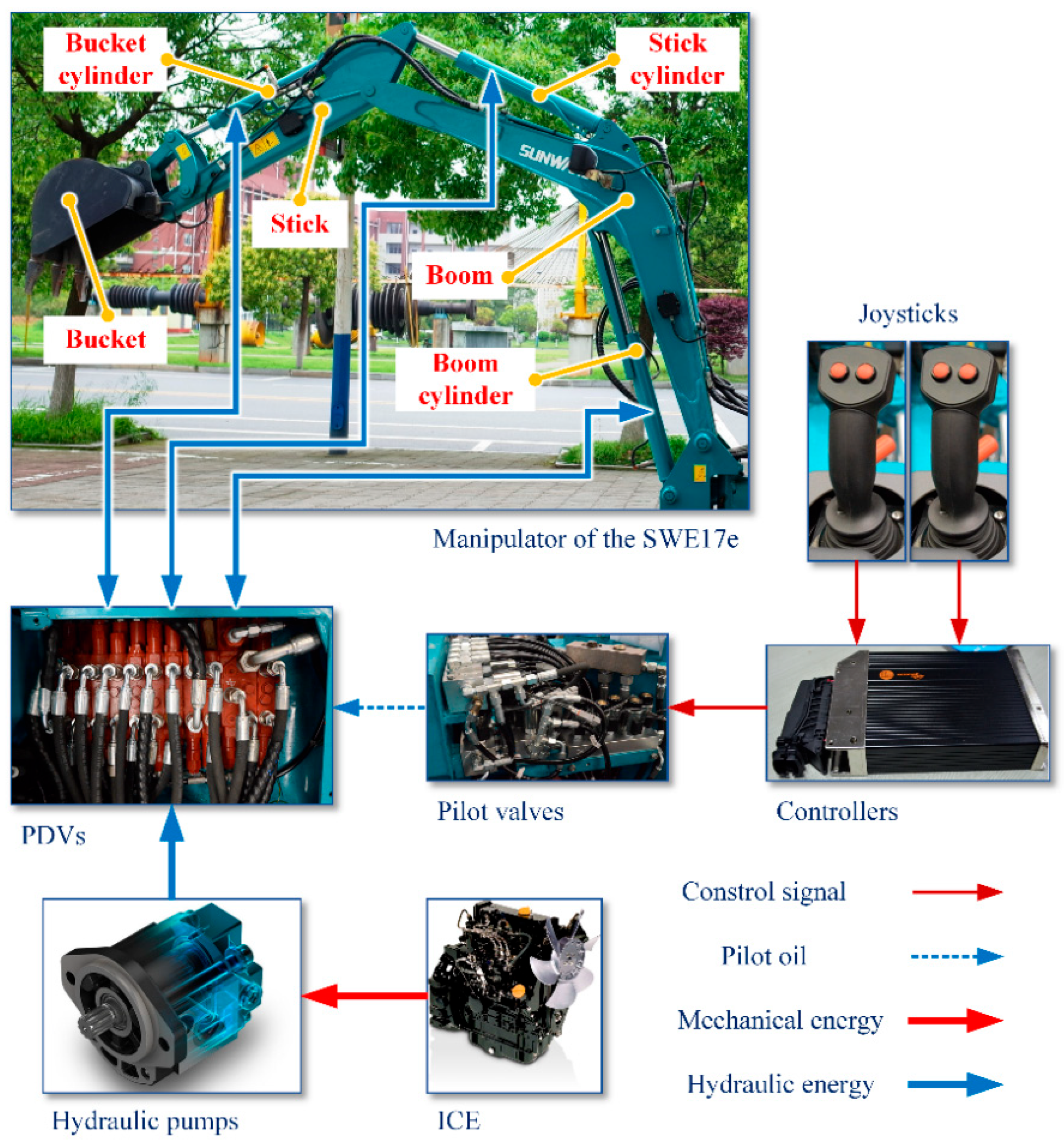
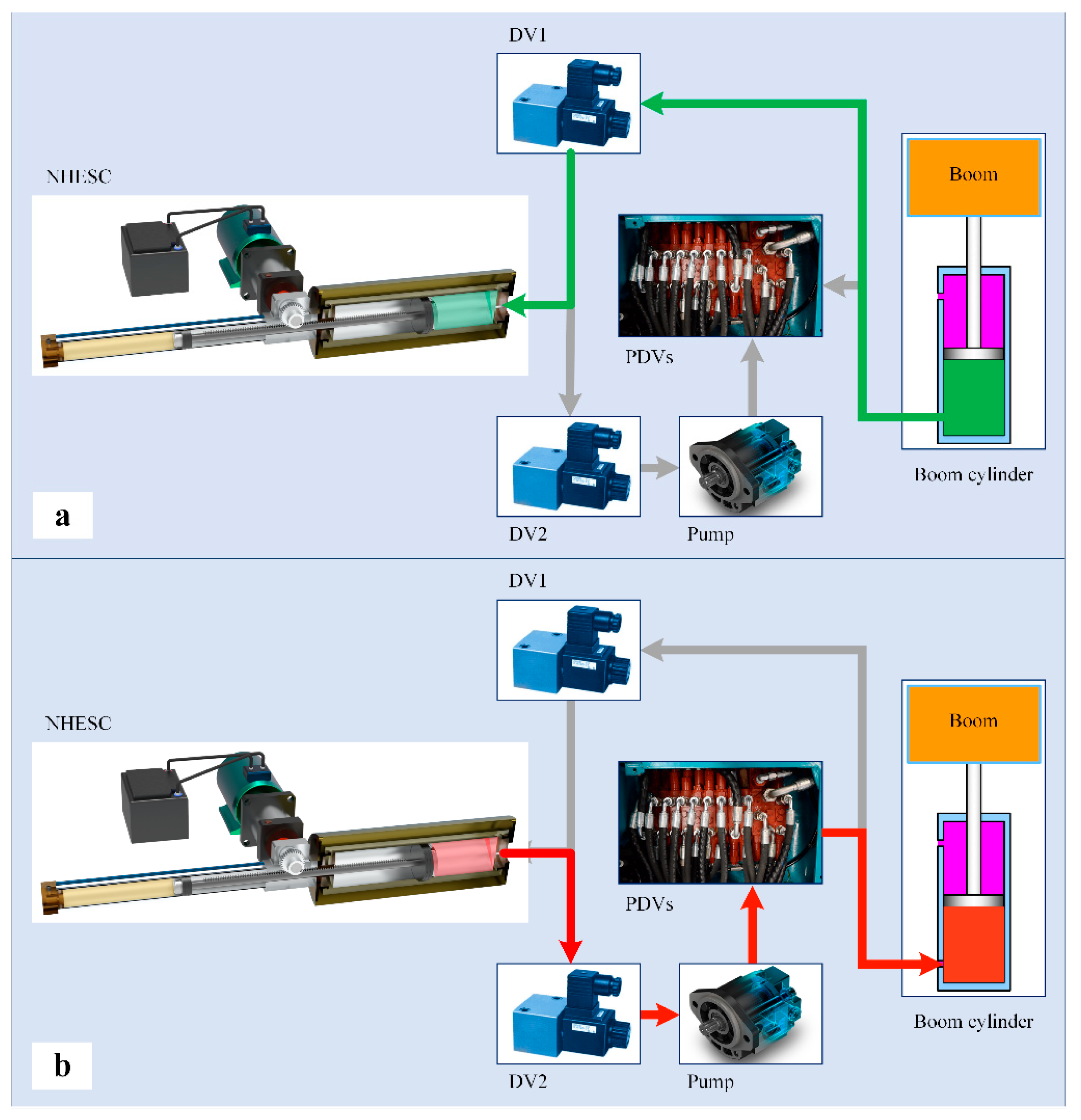
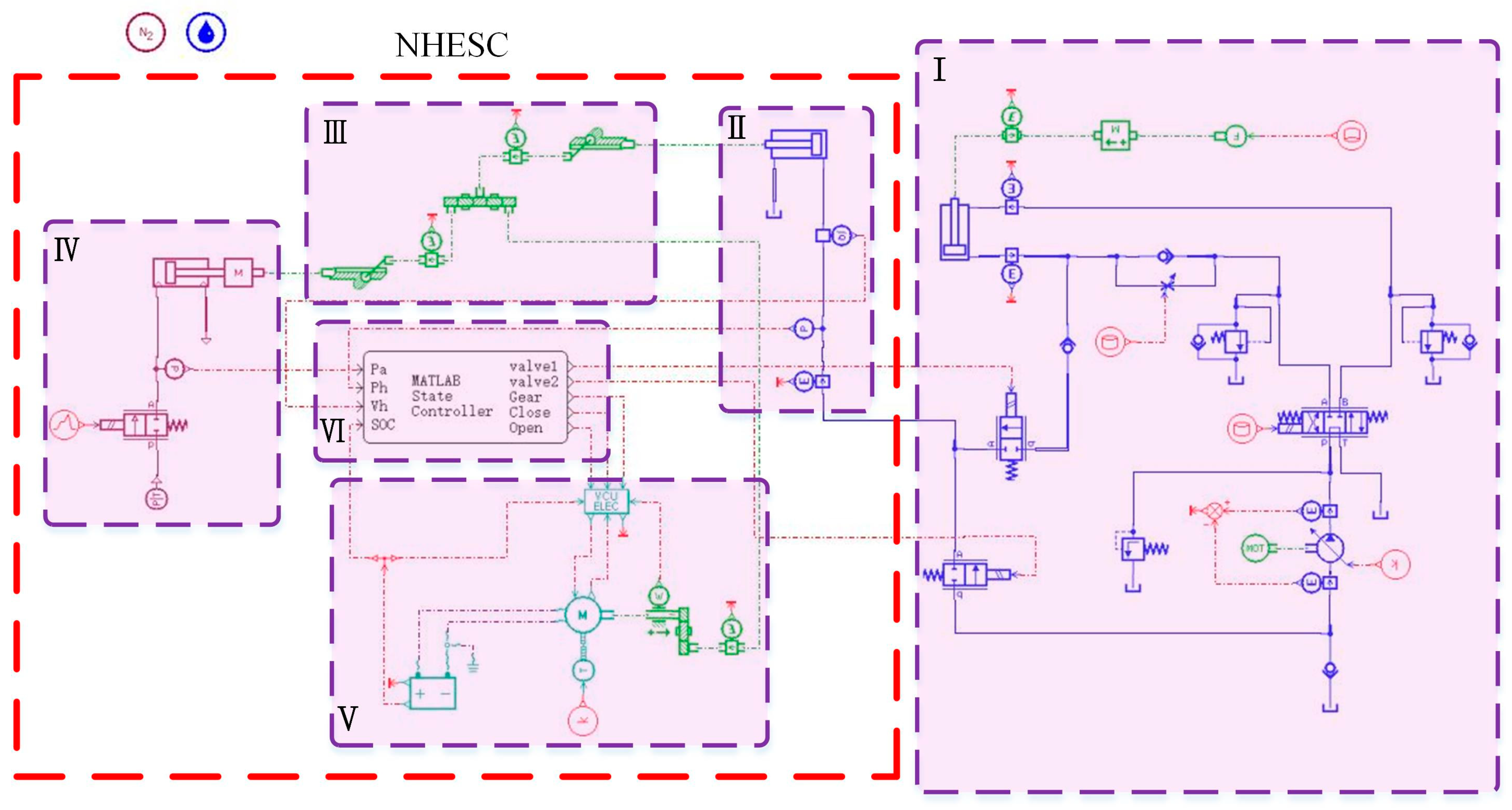

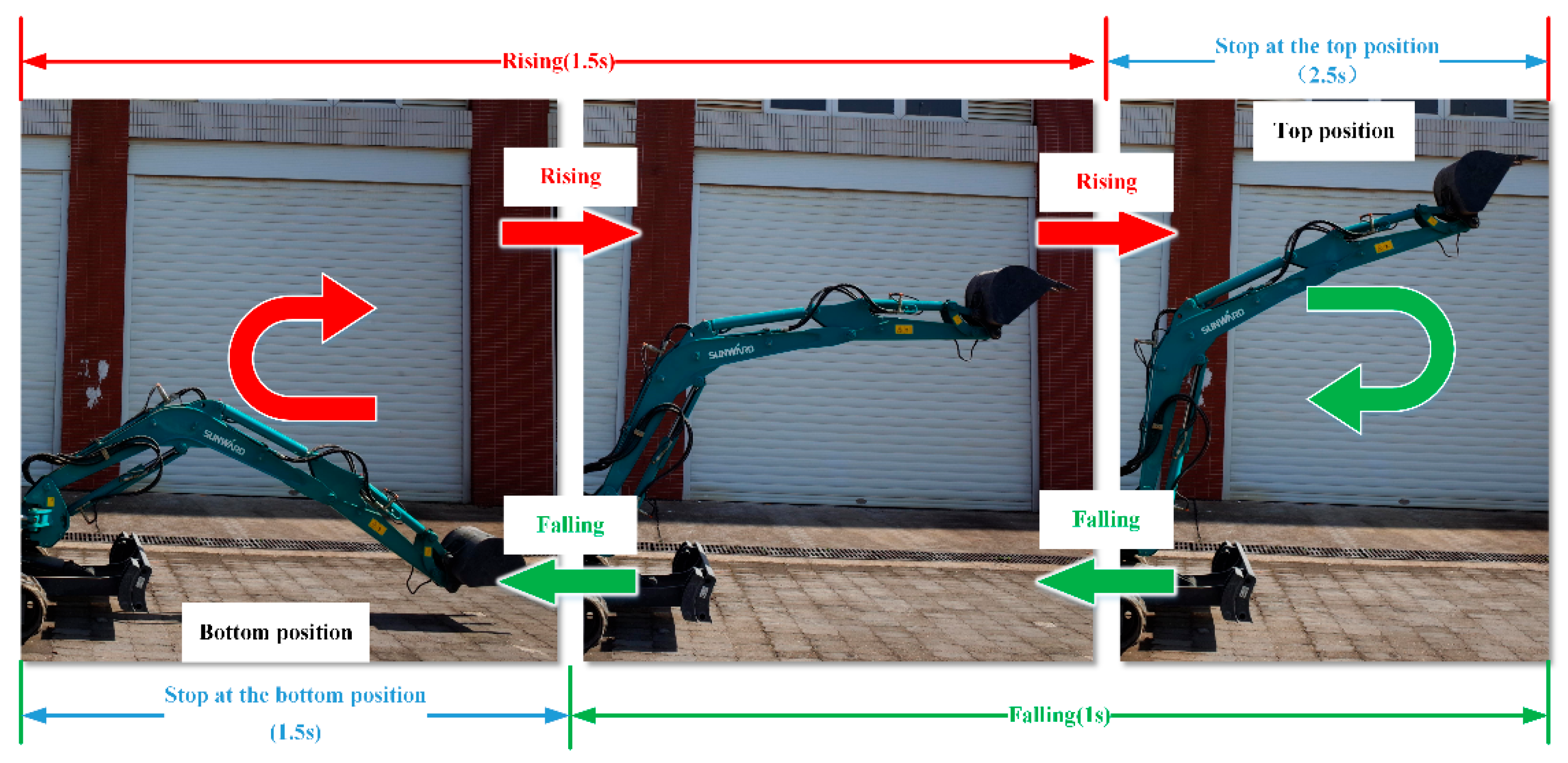
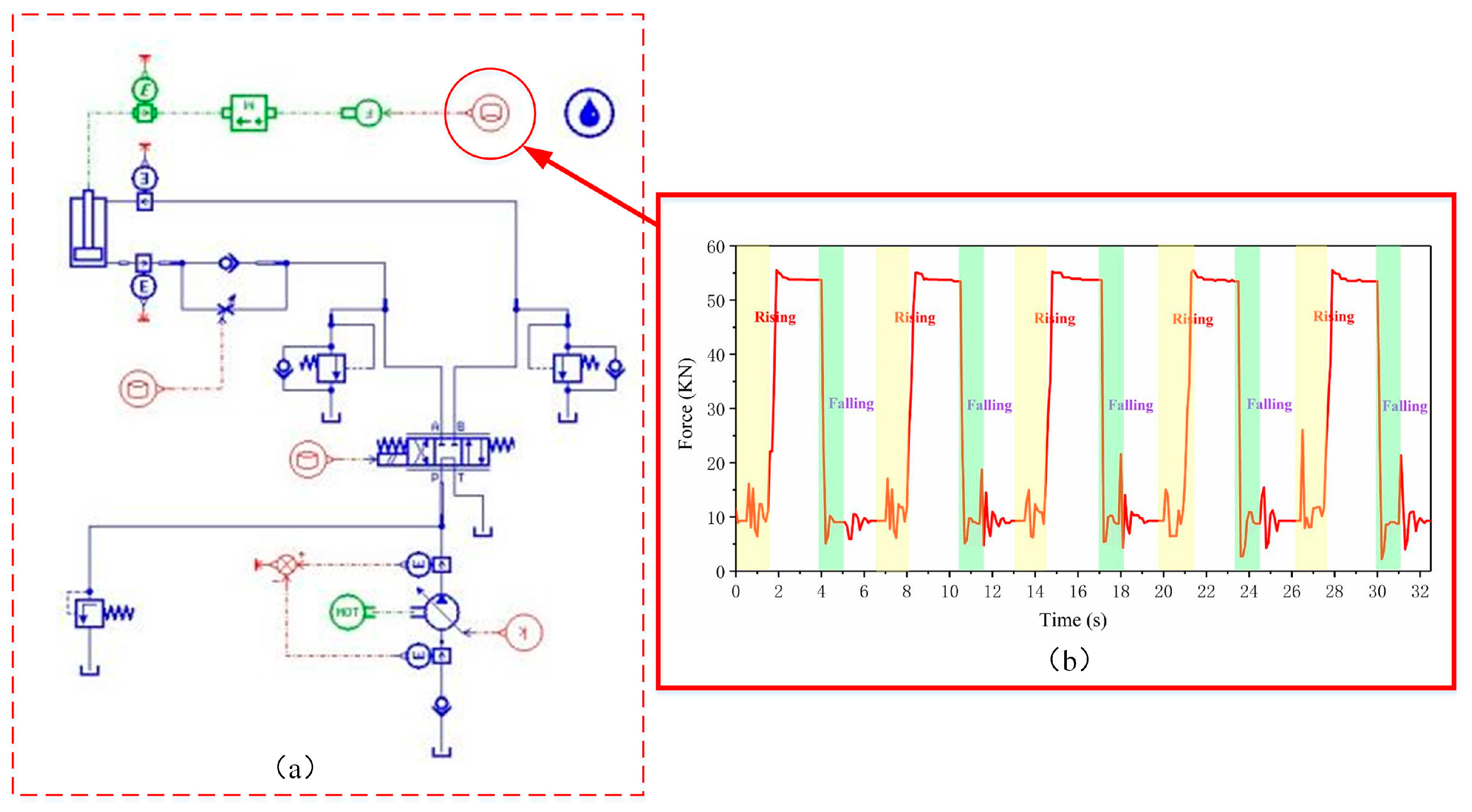
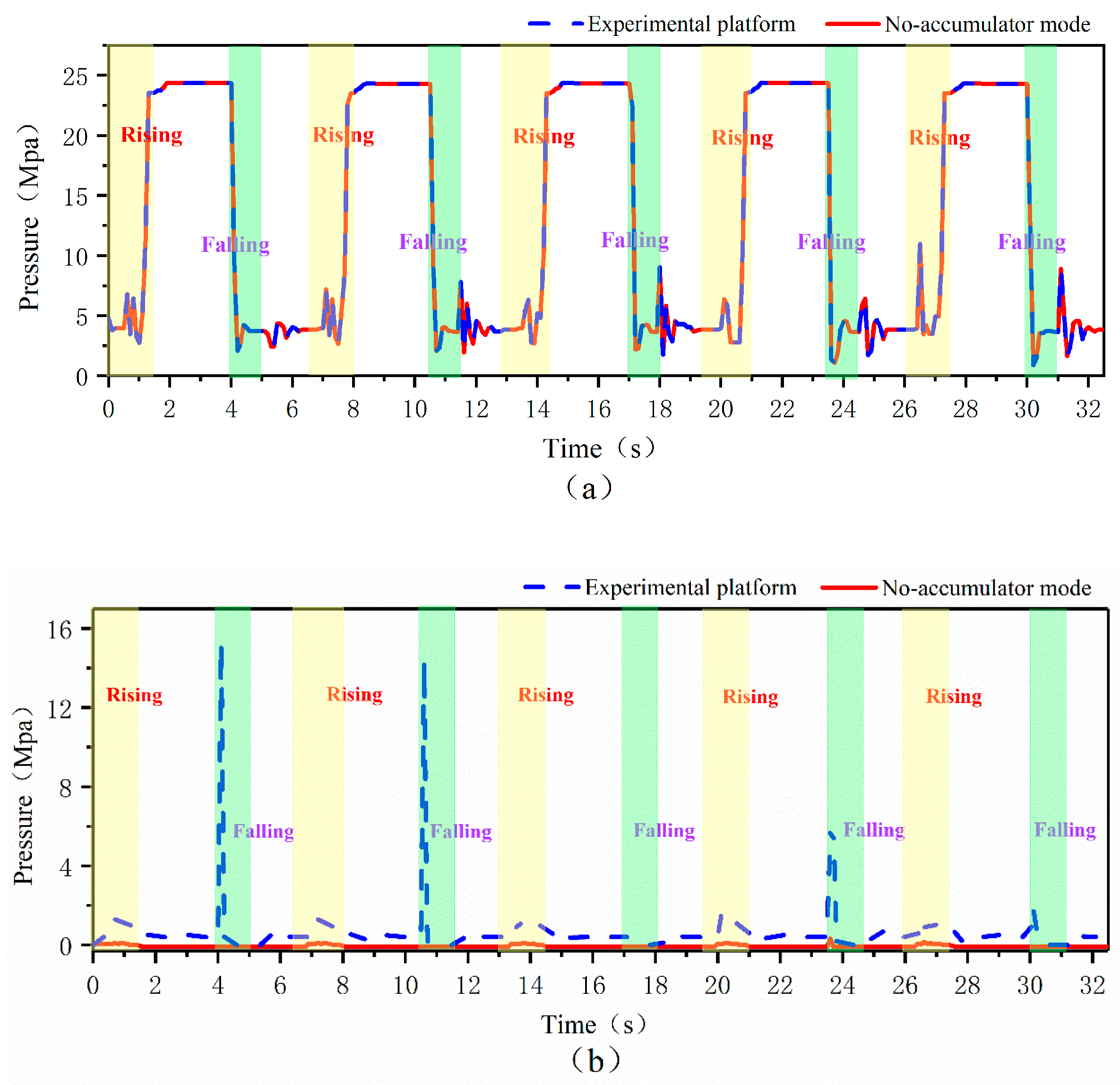
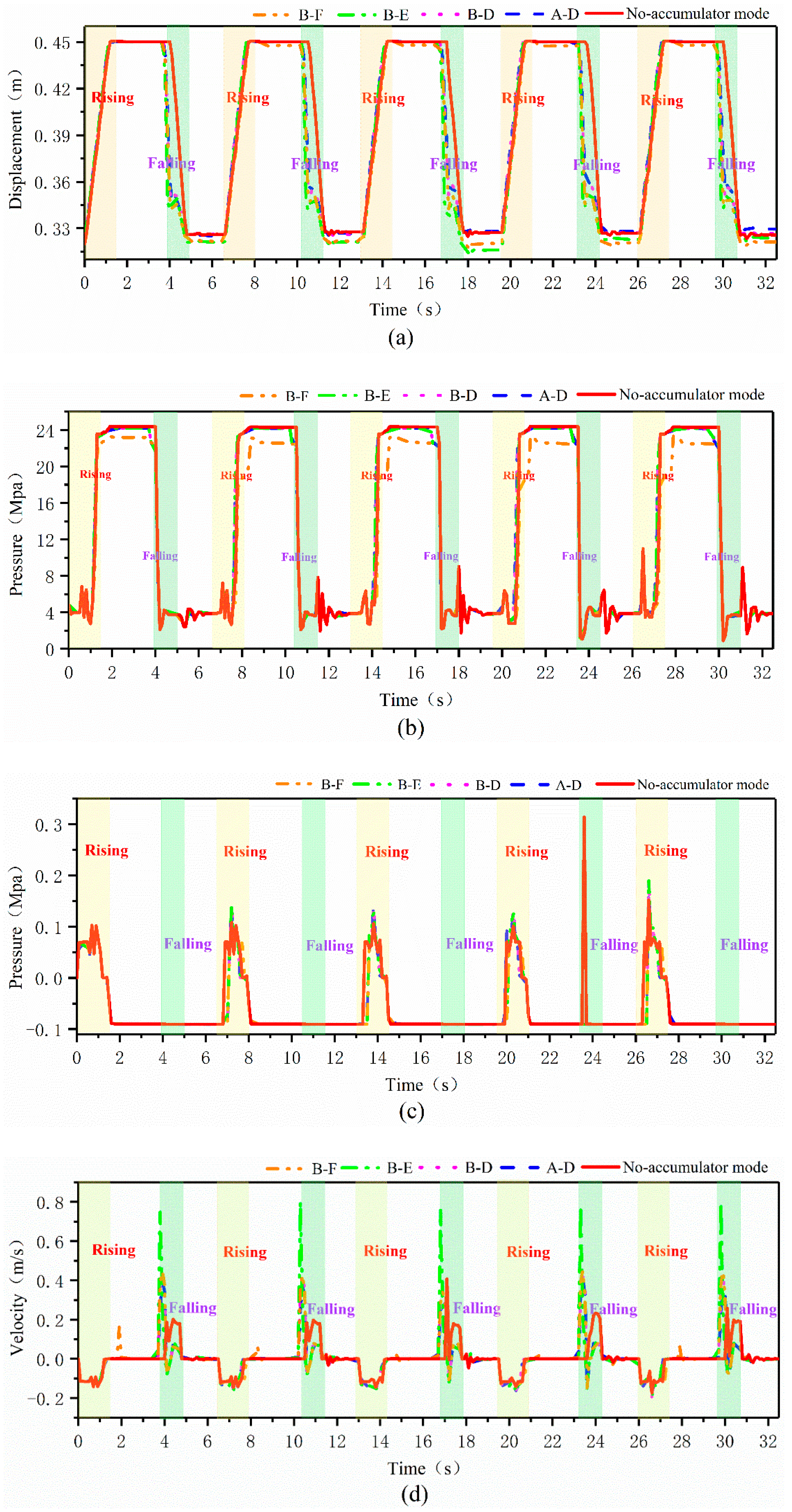
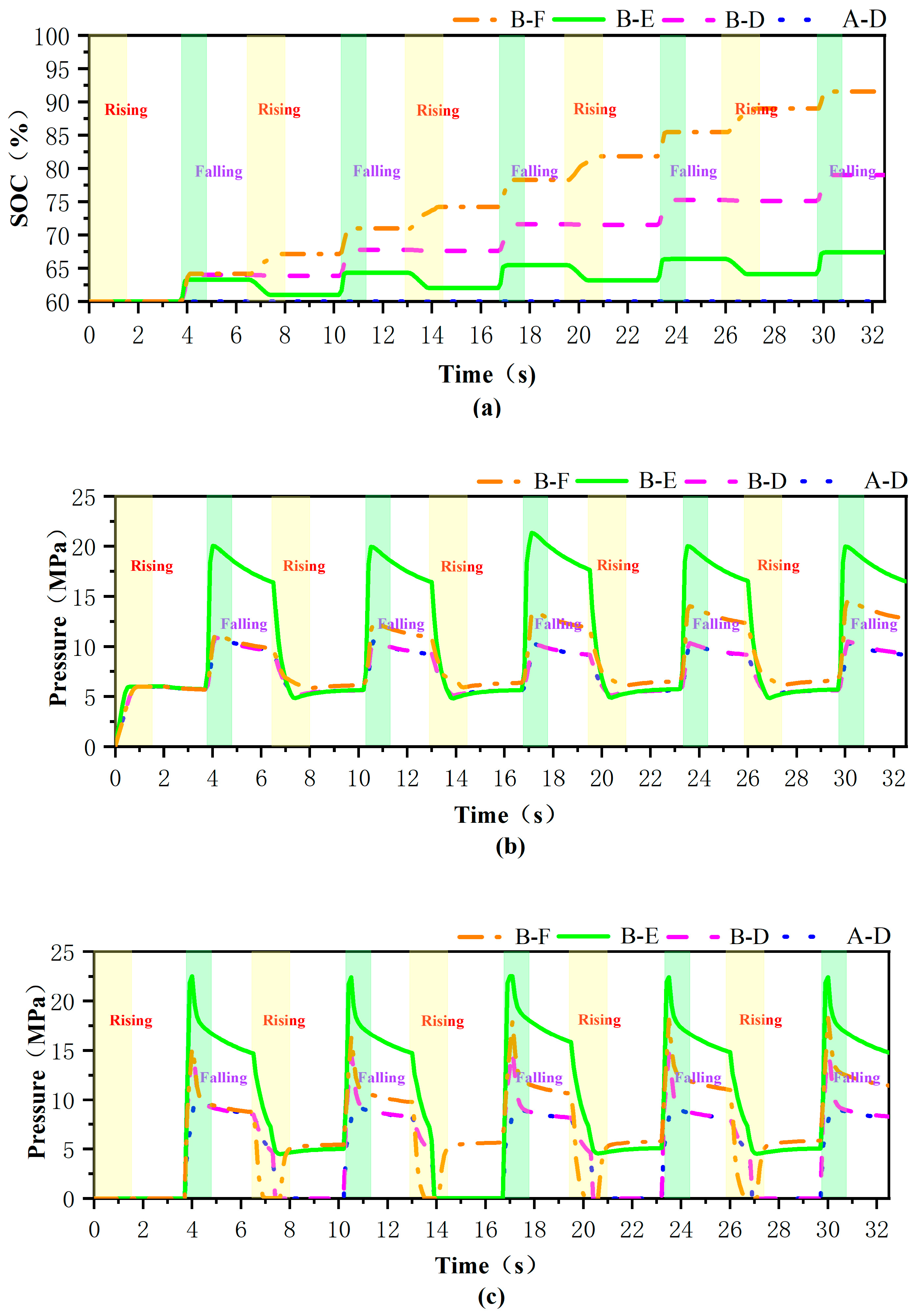
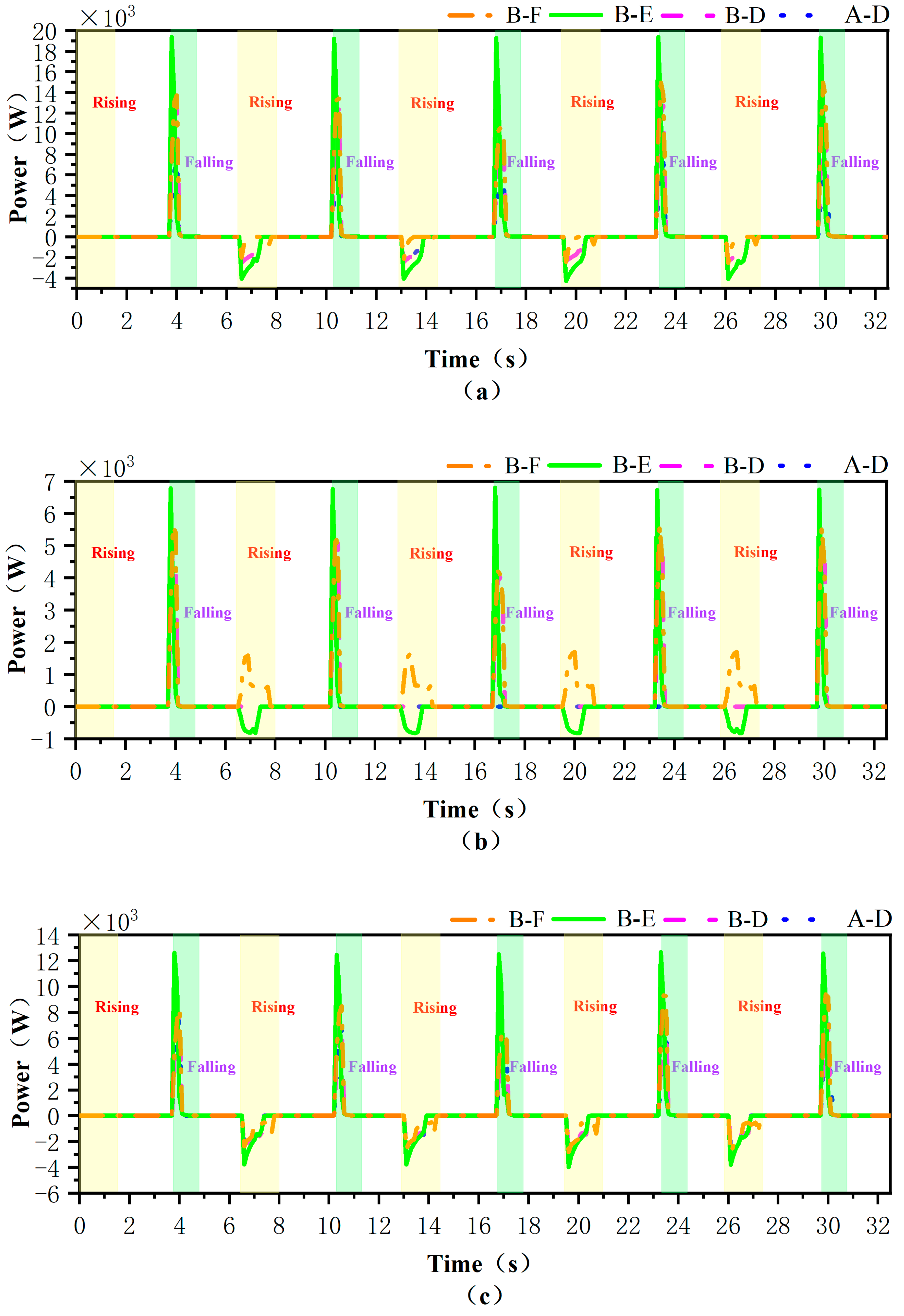


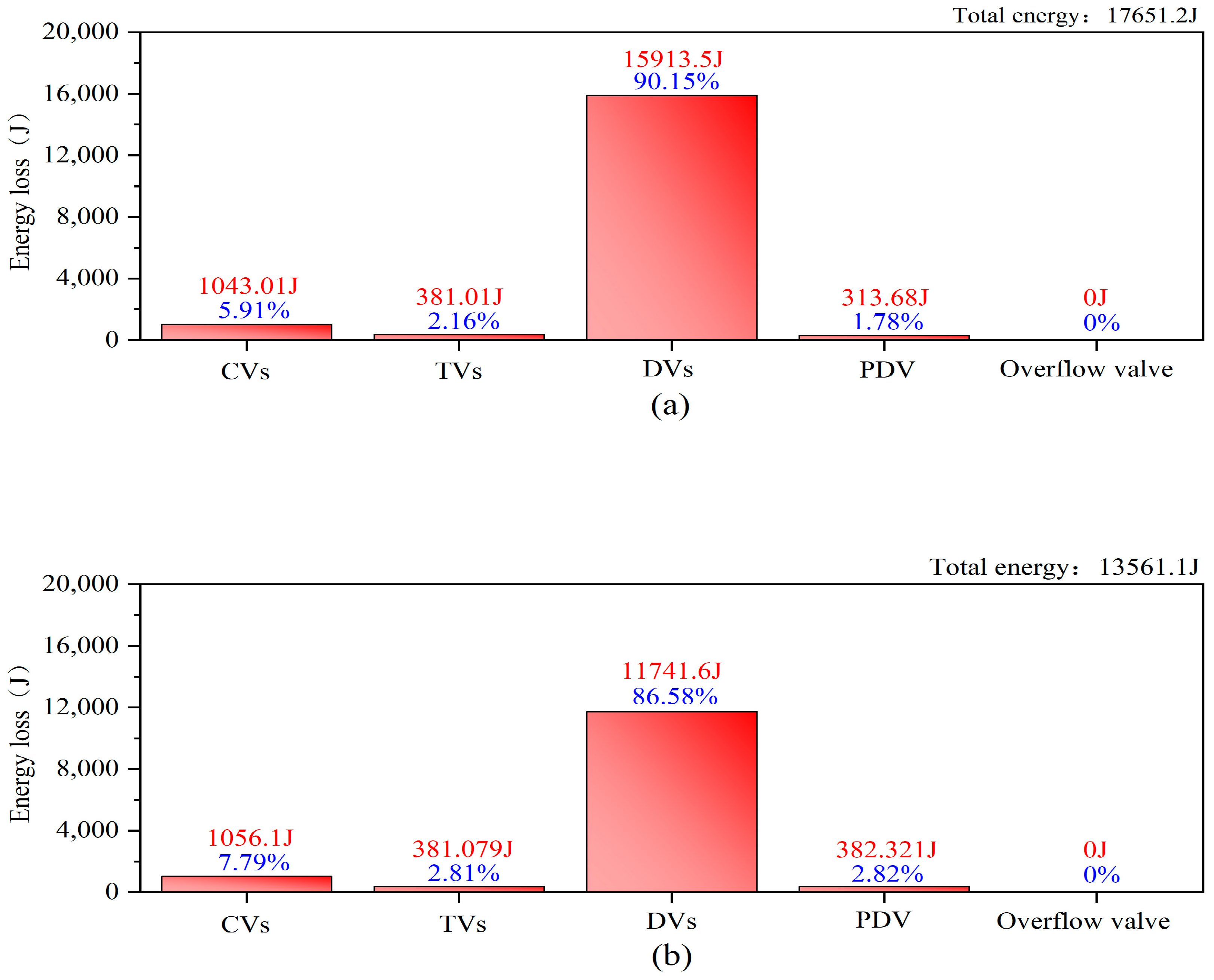
| Working States | Description |
|---|---|
| State A | The air unit independently absorbs the hydraulic energy of the hydraulic unit and stores it as compressed gas energy. |
| State B | The hydraulic energy of the hydraulic unit is simultaneously absorbed by both the air unit and the electrical unit, and is stored as compressed gas energy and electric energy, respectively. |
| State C | The air unit simultaneously recovers the hydraulic energy of the hydraulic unit and the electrical energy of the electrical unit, storing them as compressed gas energy. |
| State D | The air unit releases the stored compressed air energy and converts it into the hydraulic energy of the hydraulic unit. |
| State E | The air unit and the electrical unit simultaneously release the stored compressed air energy and electrical energy, converting them into hydraulic energy for the hydraulic unit. |
| State F | The compressed air energy stored in the air unit can be released and converted into hydraulic energy for the hydraulic unit and electrical energy for the electrical unit, respectively. |
| Component. | Parameters | Value |
|---|---|---|
| Hydraulic pump | Displacement | 9 cc/r |
| ICE | Maximum speed | 2000 rpm |
| PDV | Maximum opening flow | 20 L/min |
| Boom cylinder | Length of stroke | 0.45 m |
| Rod diameter | 30 mm | |
| Piston diameter | 55 mm | |
| Overflow valve | Maximum overflow pressure | 240 bar |
| Component | Parameter | Value | Unit |
|---|---|---|---|
| Pump | Maximum displacement | 9 | cc/rev |
| Typical pump speed | 2000 | rev/min | |
| Boom cylinder | Piston diameter | 55 | mm |
| Rod diameter | 30 | mm | |
| Length of stroke | 0.45 | m | |
| Relief valve | Relief valve cracking pressure | 240 | bar |
| Relief valve flow rate pressure gradient | 100 | L/min/bar | |
| 3-position 4-port valve | Valve rated current | 40 | mA |
| Flow rate at maximum opening | 20 | L/min | |
| 2-position 2-port valves | Saturation of input value | 1 | |
| Flow rate at maximum opening | 20 | L/min | |
| Counterbalance valve | Setting pressure | 245 | bar |
| Throttle valve | Orifice equivalent diameter at maximum opening | 20 | mm |
| Maximum flow coefficient | 0.7 |
| Component | Parameter | Value | Unit |
|---|---|---|---|
| Accumulator | Accumulator volume | 0.6 | L |
| Gas pre-charge pressure | 60 | bar | |
| Hydraulic unit | Piston diameter | 40 | mm |
| Rod diameter | 20 | mm | |
| Length of stroke | 0.3 | m | |
| Air unit | Piston diameter | 38 | mm |
| Rod diameter | 20 | mm | |
| Length of stroke | 0.3 | m | |
| Gas pre-charge pressure | 60 | bar |
| Component | Type | Number | Specification |
|---|---|---|---|
| Controller | IFM CR0020 | 4 | Channels: 64 |
| Pressure sensor | IFM PT3350 | 3 | Measuring range: 0–400 bar |
| Tilt sensor | Hemsor HS_X360 | 1 | Measuring range: 0–360° |
| CAN-TCP/IP protocol converter | CE101 | 1 | CANBus baud rate: 50k-1 Mbps |
| Industrial router | TD3024-5Y | 1 | Transmission rate: 300 Mbps (WIFI)/1000 Mbps (TCP/IP) |
| Data acquisition platform | Thankpad T430s | 1 | |
| CANBus | 2.0B | - |
| Working State Pair | Descriptions of the Working Principle |
|---|---|
| A-D | During energy recovery, NHESC operates in state A, and during energy reuse, it operates in state D. |
| B-D | During energy recovery, NHESC operates in state B, and during energy reuse, it operates in state D. |
| B-E | During energy recovery, NHESC operates in state B, and during energy reuse, it operates in state E. |
| B-F | During energy recovery, NHESC operates in state B, and during energy reuse, it operates in state F. |
| Mode | Energy Recovery Process | Recovery Efficiency |
|---|---|---|
| Accumulator mode | 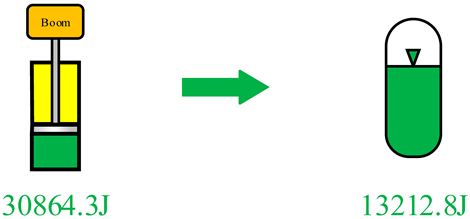 |  |
| NHESC mode B-E |  |  |
| Mode | Energy Reuse Process | Reuse Efficiency |
|---|---|---|
| Accumulator mode |  |  |
| NHESC mode B-E |  |  |
| Mode | Accumulator | NHESC Mode B-E |
|---|---|---|
| Regenerative efficiency |  |  |
Disclaimer/Publisher’s Note: The statements, opinions and data contained in all publications are solely those of the individual author(s) and contributor(s) and not of MDPI and/or the editor(s). MDPI and/or the editor(s) disclaim responsibility for any injury to people or property resulting from any ideas, methods, instructions or products referred to in the content. |
© 2025 by the authors. Licensee MDPI, Basel, Switzerland. This article is an open access article distributed under the terms and conditions of the Creative Commons Attribution (CC BY) license (https://creativecommons.org/licenses/by/4.0/).
Share and Cite
Yao, J.; He, X.; Yang, Y.; Zhu, Y.; Xiao, G.; Huang, Y. Design and Analysis of a Novel Hydraulic Energy Storage Component. Machines 2025, 13, 325. https://doi.org/10.3390/machines13040325
Yao J, He X, Yang Y, Zhu Y, Xiao G, Huang Y. Design and Analysis of a Novel Hydraulic Energy Storage Component. Machines. 2025; 13(4):325. https://doi.org/10.3390/machines13040325
Chicago/Turabian StyleYao, Jinlin, Xiangyu He, Yuanhao Yang, Yanshuo Zhu, Guangxin Xiao, and Yizhe Huang. 2025. "Design and Analysis of a Novel Hydraulic Energy Storage Component" Machines 13, no. 4: 325. https://doi.org/10.3390/machines13040325
APA StyleYao, J., He, X., Yang, Y., Zhu, Y., Xiao, G., & Huang, Y. (2025). Design and Analysis of a Novel Hydraulic Energy Storage Component. Machines, 13(4), 325. https://doi.org/10.3390/machines13040325






